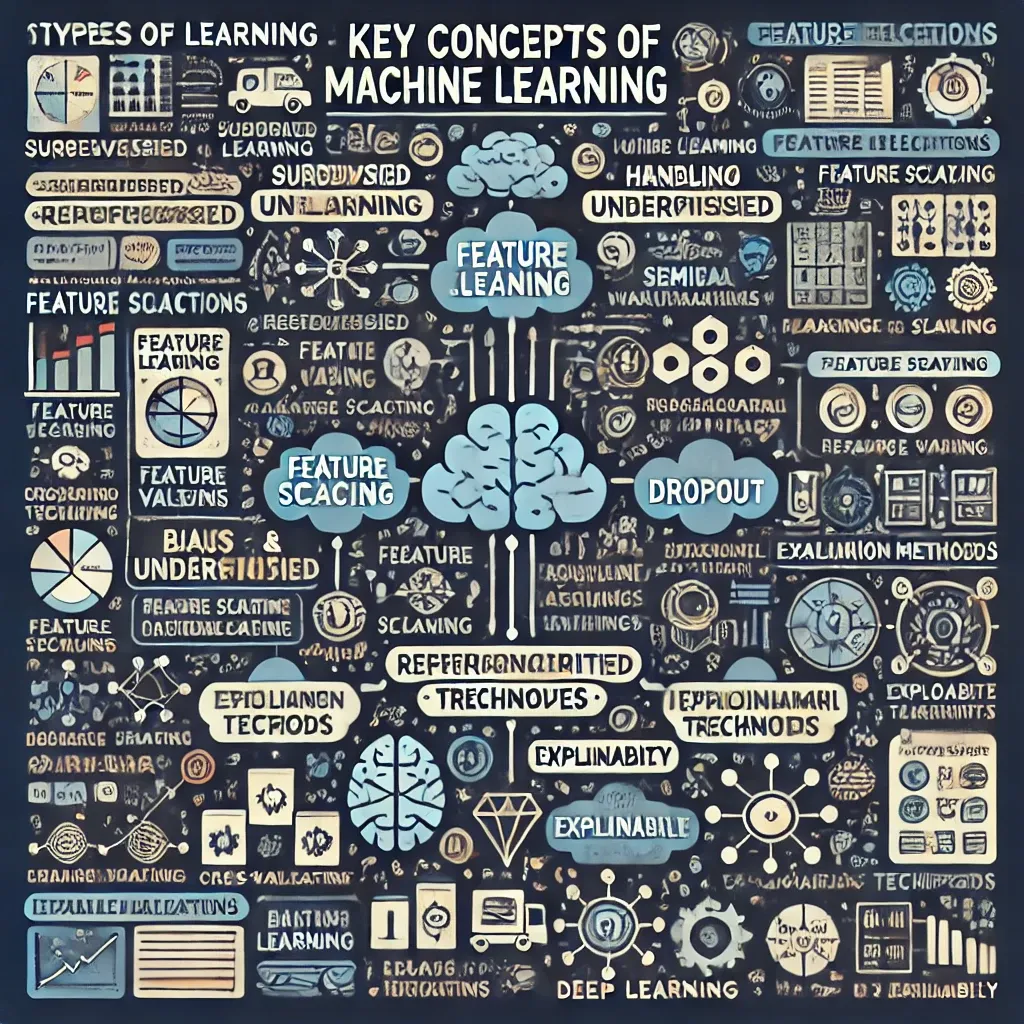Key Concepts of Machine Learning
Machine Learning (ML) is a pivotal subset of Artificial Intelligence (AI) that allows computers to learn from and make decisions based on data without being explicitly programmed for the task

Machine learning is a branch of artificial intelligence that focuses on building systems capable of learning from data, identifying patterns, and making decisions with minimal human intervention. The key concepts of machine learning encompass a range of principles and techniques that enable these systems to function effectively. Understanding these concepts is essential for anyone looking to delve into the field or apply machine learning solutions to real-world problems.
Here are the fundamental concepts:
- Types of Machine Learning:
- Supervised Learning: Learning from labeled data to make predictions or classifications. Examples include regression and classification tasks.
- Unsupervised Learning: Identifying patterns or groupings in unlabeled data. Common techniques are clustering and dimensionality reduction.
- Reinforcement Learning: Learning optimal actions through trial and error interactions with an environment, guided by rewards and penalties.
- Semi-Supervised Learning: Combining labeled and unlabeled data to improve learning accuracy.
- Deep Learning: Utilizing neural networks with multiple layers to model complex patterns in data, particularly in image and speech recognition.
- Data Preprocessing:
- Data Cleaning: Removing noise and correcting inconsistencies in data.
- Handling Missing Values: Imputing or discarding missing data points.
- Feature Scaling: Normalizing data to ensure that each feature contributes equally to the analysis.
- Encoding Categorical Variables: Converting categorical data into numerical formats using techniques like one-hot encoding.
- Feature Engineering:
Feature Engineering Techniques
-
Feature Selection:
Identifying the most relevant variables for the model to improve performance and reduce complexity.
-
Feature Extraction:
Creating new features by transforming existing data, such as through Principal Component Analysis (PCA).
- Model Selection:
Algorithm Selection Guidelines
Choosing the Appropriate Algorithm
Selecting the right algorithm depends on the type of problem you are solving, the characteristics of the data, and the required performance criteria.
Common Algorithms
Some of the commonly used algorithms include:
- Linear Regression
- Decision Trees
- Support Vector Machines (SVM)
- Neural Networks
- Training Algorithms:
Model Training Enhancements
Optimization Techniques:
Methods like Gradient Descent are used to minimize the loss function during model training. These techniques ensure that the model learns by gradually adjusting weights to find the optimal solution.
Hyperparameter Tuning:
Hyperparameter Tuning involves adjusting parameters that control the learning process, such as learning rate, batch size, or number of layers, to improve model performance and achieve better results.
- Overfitting and Underfitting:
- Overfitting: When a model learns the training data too well, including its noise, leading to poor generalization to new data.
- Underfitting: When a model is too simple to capture the underlying structure of the data.
- Regularization Techniques:
- Methods like L1 (Lasso) and L2 (Ridge) regularization that add a penalty for larger coefficients to prevent overfitting.
- Dropout: In neural networks, randomly ignoring certain neurons during training to reduce overfitting.
- Evaluation Metrics:
- Classification Metrics: Accuracy, Precision, Recall, F1-Score, ROC-AUC curve.
- Regression Metrics: Mean Squared Error (MSE), Root Mean Squared Error (RMSE), Mean Absolute Error (MAE).
- Cross-Validation:
- Techniques like k-fold cross-validation used to assess how the results of a model will generalize to an independent dataset.
- Ensemble Methods:
- Bagging: Training multiple models on random subsets of data and aggregating their predictions.
- Boosting: Sequentially training models to correct the errors of previous models.
- Stacking: Combining multiple models using a meta-learner to improve predictions.
- Bias-Variance Tradeoff:
- Balancing the model's complexity to minimize total error, which is a combination of bias (error from erroneous assumptions) and variance (error from sensitivity to small fluctuations in the training set).
- Ethical Considerations:
- Data Privacy: Ensuring the protection of sensitive information.
- Bias and Fairness: Recognizing and mitigating biases in data and algorithms to promote fairness.
- Explainability: Making models transparent and understandable to build trust and comply with regulations.
- Deployment and Monitoring:
- Model Deployment: Integrating the machine learning model into a production environment.
- Monitoring Performance: Continuously tracking model performance to detect drift and retrain models as necessary.
- Reinforcement Learning Concepts:
- Agents and Environments: The agent learns to make decisions by interacting with the environment.
- Rewards and Policies: The agent aims to maximize cumulative rewards by following a policy that dictates its actions.
- Deep Learning Architectures:
- Convolutional Neural Networks (CNNs): Specialized for processing grid-like data such as images.
- Recurrent Neural Networks (RNNs): Designed for sequential data, like time series or natural language.
- Optimization Algorithms:
- Adam: An optimization algorithm that combines momentum and RMSProp, adjusting learning rates adaptively.
- RMSProp and Adagrad: Algorithms that adjust the learning rate based on the average of recent magnitudes of the gradients.
Understanding these key concepts provides a solid foundation for exploring machine learning in depth. They are essential for developing models that are not only accurate but also robust, scalable, and ethically sound.